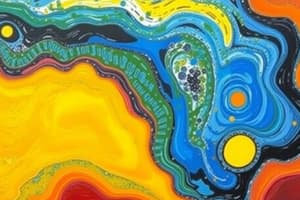Podcast
Questions and Answers
El término 'sopa ______' se refiere a la colección hipotética de productos químicos que, aunque no estaban vivos, contenían todos los ingredientes necesarios para que la vida evolucionara eventualmente.
El término 'sopa ______' se refiere a la colección hipotética de productos químicos que, aunque no estaban vivos, contenían todos los ingredientes necesarios para que la vida evolucionara eventualmente.
primordial
La 'sopa ______' consistía principalmente en aminoácidos, ácidos grasos y nucleótidos.
La 'sopa ______' consistía principalmente en aminoácidos, ácidos grasos y nucleótidos.
primordial
La ______ es el proceso por el cual la vida surgió a partir de materia no viva.
La ______ es el proceso por el cual la vida surgió a partir de materia no viva.
abiogénesis
La ______ de Miller-Urey es un experimento famoso que simuló las condiciones de la Tierra primitiva para demostrar la formación de compuestos orgánicos a partir de químicos simples.
La ______ de Miller-Urey es un experimento famoso que simuló las condiciones de la Tierra primitiva para demostrar la formación de compuestos orgánicos a partir de químicos simples.
La ______ y la abiogénesis siguen siendo conceptos centrales en el campo de la investigación sobre el origen de la vida.
La ______ y la abiogénesis siguen siendo conceptos centrales en el campo de la investigación sobre el origen de la vida.
El experimento de ______ simuló las condiciones prebióticas en la Tierra primitiva.
El experimento de ______ simuló las condiciones prebióticas en la Tierra primitiva.
La sopa ______ se refiere a la mezcla de compuestos orgánicos presentes en los océanos primitivos.
La sopa ______ se refiere a la mezcla de compuestos orgánicos presentes en los océanos primitivos.
La ______ es el proceso natural mediante el cual se cree que surgió la vida a partir de materia inorgánica.
La ______ es el proceso natural mediante el cual se cree que surgió la vida a partir de materia inorgánica.
Miller y Urey descubrieron la presencia de ______ en su experimento, que son los bloques de construcción de las proteínas.
Miller y Urey descubrieron la presencia de ______ en su experimento, que son los bloques de construcción de las proteínas.
El experimento de Miller-Urey utilizó ______ para simular los relámpagos en la atmósfera primitiva.
El experimento de Miller-Urey utilizó ______ para simular los relámpagos en la atmósfera primitiva.
Flashcards are hidden until you start studying
Study Notes
Understanding the Origin of Life: Focusing on the Miller-Urey Experiment, Primordial Soup, and Abiogenesis
The quest to understand the origin of life is a fascinating journey that explores various theories and hypotheses. Three significant areas within this field are the Miller-Urey experiment, primordial soup, and abiogenesis. Let's delve deeper into each concept.
Miller-Urey Experiment
The Miller-Urey experiment, also known as the spark discharge experiment, was conducted by Stanley Miller and his mentor Harold Urey in 1953. Their goal was to simulate prebiotic conditions on Earth and investigate whether organic molecules could be generated from inorganic precursors. They used a sealed glass flask containing methane, water, ammonia, and hydrogen. Electric sparks were introduced into the mixture to mimic lightning, and the flask was heated slowly to create an atmosphere similar to that of the early Earth.
After running the experiment for a week, Miller and Urey collected samples from the bottom of the flask and analyzed them. They discovered the presence of amino acids, which are the building blocks of proteins. This experiment provided strong evidence that the necessary building blocks of life could indeed be formed under prebiotic conditions, laying the foundation for subsequent research in the field.
Primordial Soup
The term "primordial soup" refers to the hypothetical collection of chemicals that, while not alive themselves, contained all the necessary ingredients for life to eventually evolve. This concept grew out of the Oparin-Haldane theory, which proposed that life emerged from a mixture of organic compounds that accumulated in Earth's early oceans.
According to this model, the primordial soup consisted primarily of amino acids, fatty acids, and nucleotides, which are the building blocks of proteins, lipids, and nucleic acids, respectively. Over time, these chemicals combined and interacted, leading to the formation of more complex structures, such as polypeptides and polynucleotides. Eventually, these structures gave rise to the first living cells.
Abiogenesis
Abiogenesis is the process by which life arose from nonliving matter. It is widely regarded as the most likely explanation for the origin of life on Earth. Although the exact sequence of events leading to the appearance of life remains a subject of ongoing research, several factors are believed to have contributed to the transition from nonliving to living matter:
-
Availability of constituents: The presence of abundant raw materials needed for life, such as carbon, hydrogen, nitrogen, oxygen, and water, facilitated the formation of organic compounds.
-
Energy sources: The availability of energy in the form of light, heat, and electrical discharges, such as lightning, provided the necessary driving force for chemical reactions.
-
Conditions favorable for reaction: Prebiotic environments, such as hydrothermal vents and warm shallow seas, provided the appropriate conditions for chemical reactions to occur.
-
Spontaneous self-assembly: Simple organic compounds spontaneously assembled into larger structures, potentially forming proto-cells or early membranes.
Although numerous theories exist regarding the origin of life, the Miller-Urey experiment, primordial soup, and abiogenesis remain central concepts in the field. Continued research in these areas aims to shed light on the mysterious puzzle of how life emerged from nonliving matter on Earth billions of years ago.
Studying That Suits You
Use AI to generate personalized quizzes and flashcards to suit your learning preferences.




